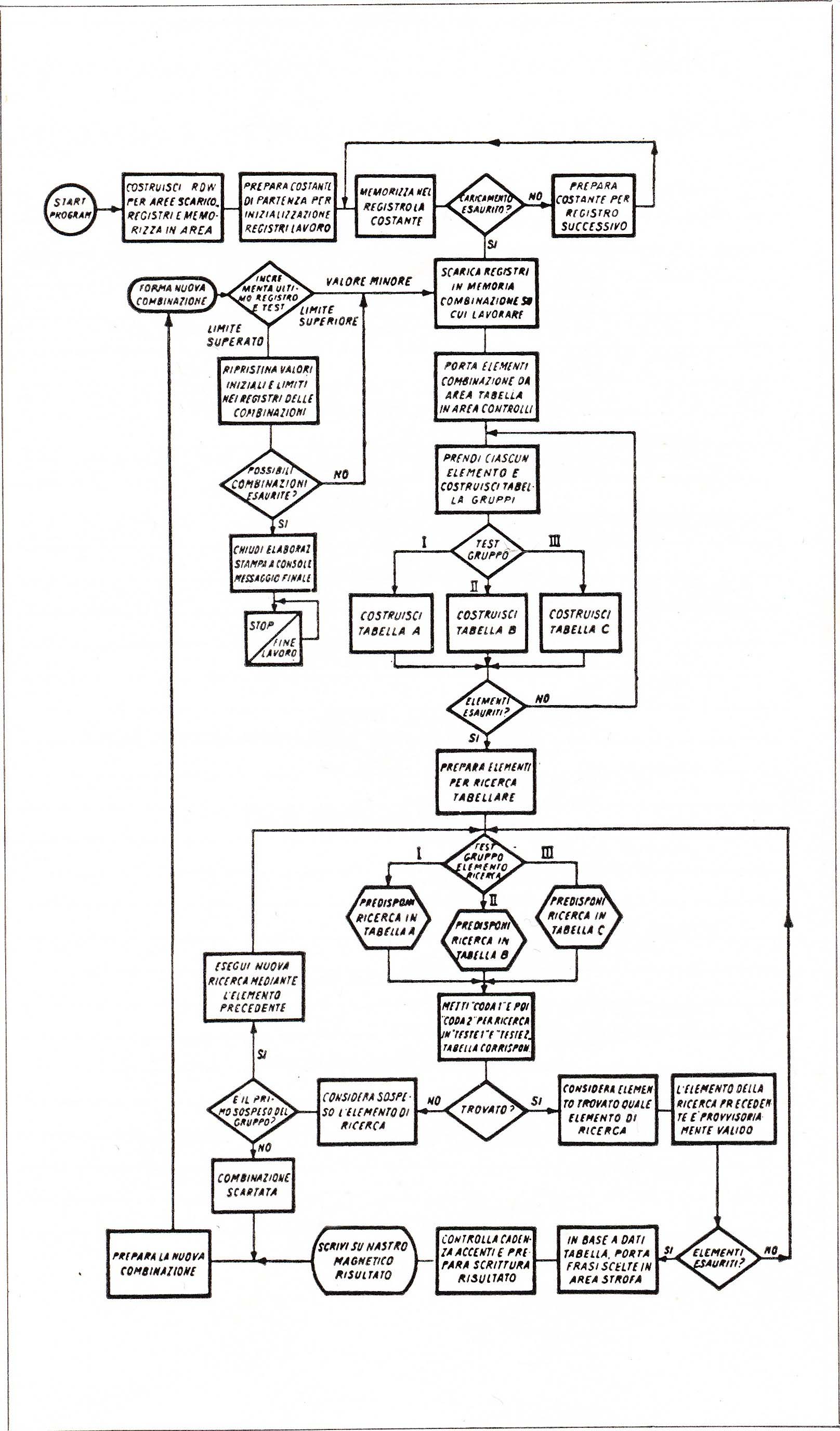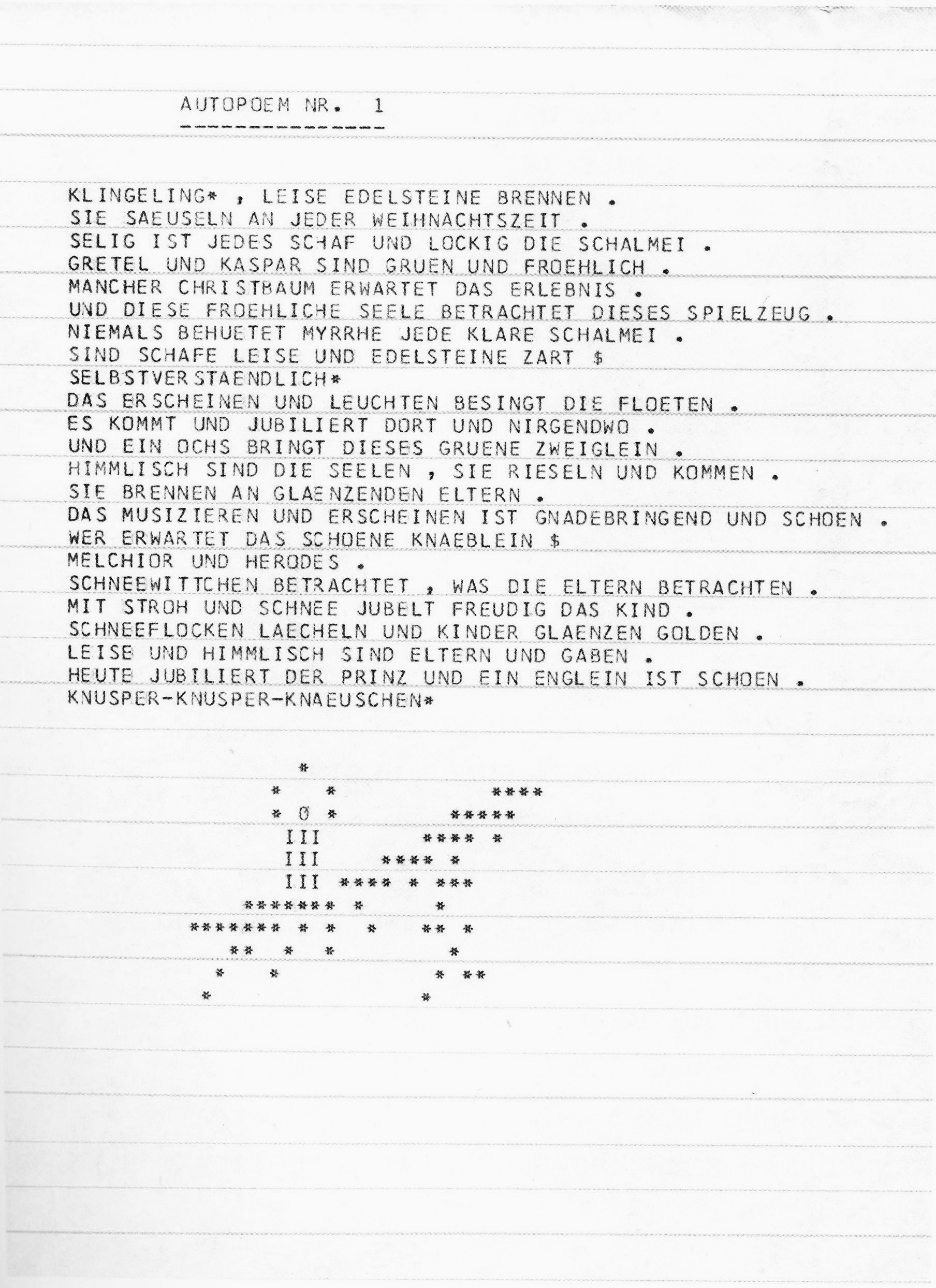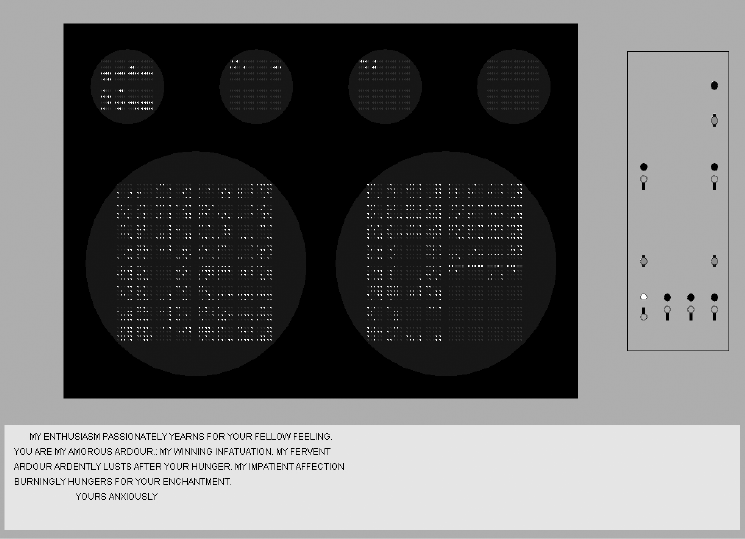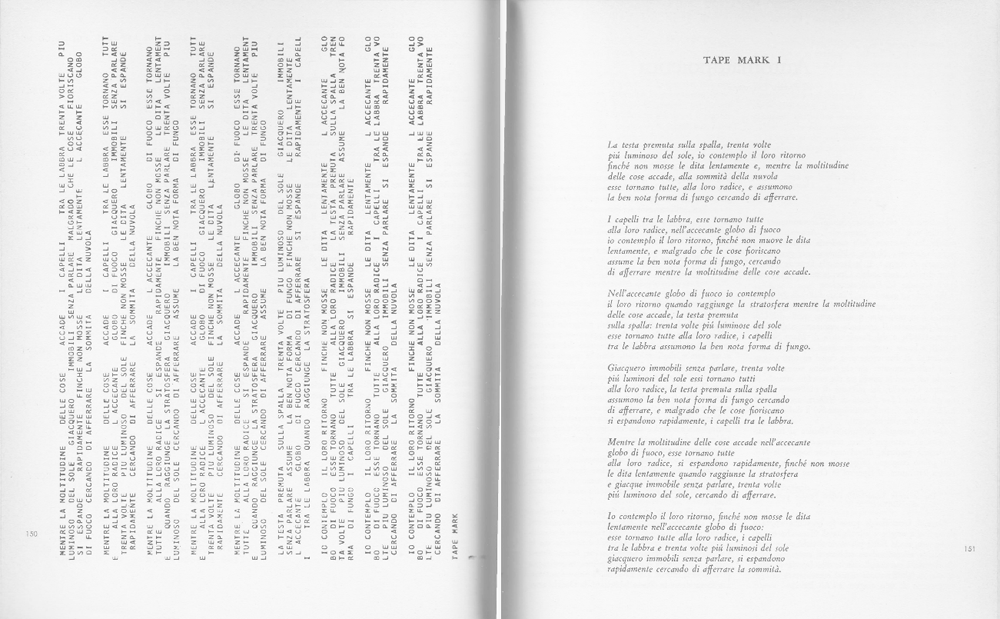IASLonline NetArt: Theory
Thomas Dreher
History of Computer Art
III. Information Aesthetics
III.1 Computer Literature
- III.1.1 Word Processing
- III.1.2 Christopher Strachey´s "Love-letters"
- III.1.3 Stochastic Texts
- Illustrations Part III: Information Aesthetics: PPT / PDF
- Table of Contents
- Bibliography
- Previous Chapter
- Next Chapter
The previous chapter on "Cybernetic Sculptures" (see chap. II.3) presents the development of systems from 1953 to 1971 integrating self constructed computers (see chap. II.3.1.1, II.3.2.3), analog computers (see chap. II.3.2.2) and digital minicomputers (since 1969, see chap. II.3.3, II.3.2.2, II.3.4): Alternatives to mainframe computers were constructed to make possible the inclusion of computers in installations (that can be rebuild on several locations).
With the use of mainframe computers in electronic literature an alternative was developed to electronic data processing as a means for administrative needs. The history of an experimental utilisation of mainframe computers to test their possibilities for word processing began in the fifties. In contrast to the cybernetic sculptures the computers are not a part of a work that can be categorized as computer literature or computer graphics (see chap. III.2) but a means to produce the work. The results of the computing processes are printed by plotters.
In reactive installations cybernetic circuits support the integration of the observer. In computer literature and computer graphics the circuits are reduced to the sequence from input media – punch cards or magnetic memories – to the mainframe computers executing the computing processes and the printers or plotters as output media writing letters or graphic signs on papers. These prints present the results of computing processes executing the program´s instructions. If the computing process will be restarted then the results can vary. This variety is not seldom caused by algorithms for pseudo random sequences (see chap. III.1.2, III.2.2).
Christopher Strachey met Alan Mathison Turing during his studies (of mathematics and physics, from 1935 to 1938) at King´s College in Cambridge. From 1949 to 1952 Strachey was a teacher at Harrow School (Harrow on the Hill/Middlesex). In 1951 Mike Woodger introduced Strachey to the project Pilot ACE at the National Physical Laboratory in Teddington/Middlesex. Since 1950 the laboratory developed the reduced version of Turing´s "Automatic Computing Engine" called Pilot ACE. 1 In February 1951 Strachey developed for Pilot ACE a program for a game of draughts running for the first time in 30th July 1951. As soon as Strachey received informations about the bigger main memory of the mainframe computer Manchester Mark I (1948-50) he wrote his program for a game of draughts in the machine code of this computer (October 1951, see chap. VII.1.1). 2
The Ferranti Mark I (1951) was constructed on the base of the Manchester Mark I. It was the first purchasable computer. In February 1951 Manchester University received its exemplar. A program for computer music was developed by Strachey for this Ferranti Mark I. It generated songs like "God Save the King" (1951). 3 After having presented his program Strachey was hired by the National Research and Development Corporation as a "technical officer" (June 1952).
Link, David: Ferranti Mark I Emulator with a reconstruction of Christopher Strachey´s "Love-letters" 1952 (Link: Angel 2006, p.16, fig.1).
In 1952 he wrote a program to generate "Love-letters". The program combined words by selecting them form a database via the random generator of the Ferranti Mark I. The stored word library contained a selection from Roget´s Thesaurus. The words supplied with syntax indices – "adjectives", "substantives", "adverbs" and "verbs" – are combined following two syntactical structures: "My—[adjective]—substantive—[adverb]—verb —Your—[adjective]—substantive" or "You are my—adjective—substantive". In the case of repetitions the second structure was reduced to "My—adjective—substantive". After a salutation combined by using a database called "Letter Start" to select words followed five sentences generated by combinations of stored words using the syntactical schemes described above. The end of the letter was constructed with the scheme "Yours—adverb—MUC" (MUC = Manchester University Computer). The program "Love-letters" could generate 318 billion different letters. The results of the computing processes were presented without commas by a teleprinter. Meanwhile Strachey´s "Game of Draughts" had to choose the best of all possible moves, "Love-letters" recognized only the syntactical structures but no semantic restrictions. Noah Wardrip-Fruin proposes to understand "Love-letters" as to produce semantic accidents as parodies of "normative expressions of desire". 4
Strachey anticipates basic elements of the sixties´ computer literature and computer graphics with his structuring of the programming into a selection of elements, a random generator, a syntax for combinations and the presentation of a plotter output.
Until 1959 Theo Lutz studied mathematics, physics and electrical engineering at the Technische Hochschule of Stuttgart. As a degree candidate of Max Bense he knew the philosopher´s information aesthetics. Bense proposed Lutz to install in his text generating program "a database with 100 words from Franz Kafka´s novel `The Castle´ [1922] and simple sentence structures." 5
Max Bense´s "Aesthetica" was published in five parts from 1954 to 1965. In the first part Bense explained the "classical and nonclassical Seinsthematik [epistemology]". He situates Hermann Melville´s "Bartleby" and Franz Kafka´s "The Castle" between a reality derived from divine possibilities in the sense of the classical epistemology and the nonclassical opposition between the "term of a (human, personal) existence" and the "term of a system containing everything, transcendence as well as immanence, god as well as the world, reason as well as history". 6
This epistemological discourse presented Bense in part 1 of the "Aesthetica" as a central problem of the artistic and literary avant-garde. It was taken over in later parts (since part 3, published in 1958) by explanations of the "aesthetic" and "semantic information". Bense defines "information" among others as "a measure of a scheme´s regularity". 7
In 1959 Theo Lutz´s "stochastic texts" were produced at the Rechen-Institut of the Technische Hochschule of Stuttgart in the time when Bense developed a new core subject in "Aesthetica". In Lutz´s texts the selection of words is determined by a syntactical scheme, a random generator and frequency criteria. Lutz´s program used a word database to generate with the valve computer Z22 of the firm Zuse (1958) sentences with a correct syntax. Lutz´s procedure to use the stored words provides a model for Bense´s change of "Aesthetica´s" core subject.
Lutz, Theo: Stochastic Text, Zuse Z22, teleprinter output, 1959.
Lutz used punch tapes as input medium to start his in ALGOL written program in the computer Z 22 of the Rechen-Institut. Then he could read the result on the teleprinter´s output. The database contained a selection of 16 subjects and 16 predicates as they were found in Kafka´s "The Castle". Four "logical constants" ("and", "or", "if...then", ".") for the syntax of the combinations, four "logical operators" for the subject´s existence ("one", "each", "no one" and "not each" in feminine, masculine and factual German forms) as well as the stored subjects and predicates should appear with equal frequency in a computer-generated text. Only the "relative frequency" of the point (the sign for the negation) was determined higher than the frequency of the other logical constants.
Between subject-predicate pairs the logical constants create irritating relations – for example:
Jeder Fremde ist nah, so gilt kein Fremder ist alt (If each stranger is close, then each stranger is old). 8
The second part of the if/then operation seems to be a conclusion from the first part of the phrase but this is wrong for our world knowledge. Which roles play such wrong conclusions for the poeticity of a computer-generated "artificial" literature 9: Does the artificial literature try to provocate us to understand the "aesthetic information" as a quality being independent from the "semantic information" 10 and ignoring the truth content of the message?
Bense based his integration of the semantic terms `true´ and `false´ in the information theory 11 on theories of Donald M. MacKay and Rudolf Carnap. 12 The semantic information in logics and the information in cybernetics (see chap. II.1.3) are presented as alternatives 13 that can be combined in "Aesthetica" in a "general communication research" to be able to discuss the relations between "semiotics" and "information theory". 14
Shannon´s model of a reconstructing production of a language based on frequency statistics of the use of basic elements and their combinations (see chap. II.1.2) is turned in Lutz´s "Stochastic Texts" into a procedure to obtain "aesthetic information" renouncing any dependence on conventional forms of literature. The frictions between text production and the conclusiveness of a statement in relation to the experience of reality, between "aesthetic" and "semantic information", are a key issue. The results of a machine production become experiments for readers who decide if the tension between reliable and unreliable statements is attracting or if the text provokes a collapse of their attention.
In 1960 Brion Gysin utilised a program developed by Ian Somerville for the permutation of words without regard to syntactical structures. In contrast to Lutz Gysin doesn´t install a database as an archive with combinable words but selects five words to be used in all combinations. The sequence of the words in the start phrase "I AM THAT I AM" was permuted from one line to the next until all variants were realised. 15 The relations between syntax and semantics can appear to readers of "I AM THAT I AM" cancelled by the permutation of the words with the recurring vowels "i" and "a" in varying changes with the recurring consonants "h", "m" and "t": Semantics are replaced by visual and onomatopoetic effects.

Balestrini, Nanni: Tape Mark I, Flow Chart, 1961 (Reichardt: Serendipity 1968, p.65).
Balestrini, Nanni: Tape Mark I, 1961. Left: plotter print. Right: print version (Balestrini: Tape 1962, p.150s.).
Nanni Balestrini invented for "Tape Mark I" a method to generate poems that fall between the concepts for desemantising procedures and for procedures to integrate syntax and semantics. Balestrini selected 15 words from three textual sources for an archive with stored words to be combined in October 1961 by an IBM 7070 (since 1960) of a Milanese bank. 10 words were selected from the archive and were combined with regards to syntactical structures. These combinations were merged in texts with six lines, each constituted by "four metrical elements". This process led to poetic results provoking readers to search for meaning. The poems perform neither radical semantic breaks nor do they include elements comparable to Lutz´s "logical constants" being able to cause the construction of statements without conclusiveness in relation to our experience of reality. 16

Stickel, Gerhard: Autopoem No.1, 1965 (Herzogenrath/Nierhoff-Wielk: Machina 2007, p.159).
In 1965 Gerhard Stickel reconstructed the forms of poetry. In his "Autopoems" generated between 1965 and 1966 by a mainframe computer IBM 7090 (since 1959) he circumvents the problem of the conclusiveness of a statement in relation to the experience of reality that Lutz posed with his use of "logical constants": The relations with references to reality described in Lutz´s computer-generated texts get a peripheral character by the poetic forms of Stickel´s "Autopoems". In its selection of words from a database Stickel´s program follows syntactical criteria. A random generator selects the words, the syntactical structures of phrases (280 structures in all) and the number of lines (between 4 and 26 lines). 17
Dr. Thomas Dreher
Schwanthalerstr. 158
D-80339 München
Germany.
Homepage with numerous articles
on art history since the sixties, among others on Concept Art and Intermedia
Art.
Copyright © (as defined in Creative
Commons Attribution-NoDerivs-NonCommercial 1.0) by the author, November
2011 (German version)/September 2013 (English translation).
This work may be copied in noncommercial contexts if proper credit is
given to the author and IASL online.
For other permission, please contact IASL
online.
Do you want to send us your opinion or a tip? Then send us an e-mail.
Annotations
1 Hodges: Turing 1983/1992, p.442s.; Link: Angel 2006, p.17; Turing: Proposal 1945/1992; Wardrip-Fruin: Media 2011, p.304s. back
2 Copeland: History 2000, chap. "The Manchester Machine"; Link: Angel 2006, p.17; Strachey: Machine 1954, p.27; Wardrip-Fruin: Media 2011, p.304s.,312ss. back
3 Fildes: Computer Music 2008; Link: Angel 2006, p.17s. back
4 On "Love Letters": Bülow: Sinn 2007,
p.148-151; Hodges: Turing 1983/1992, p.477s.; Link: Angel 2006; Wardrip-Fruin
2011, p.302-316. Examples: Bülow: Sinn 2007, p.150; Strachey: Machine
1954, p.26.
Re-engineering: Link, David: LoveLetters_1.0. MUC=Resurrection. A Memorial.
Exhibited in: YOU_ser 2.0. Celebration of the Consumer. ZKM/Center for
Art and Media. Karlsruhe 2009. In: URL: http://www02.zkm.de/
you/ index.php? option=com_content& view=article& id=98%3Aloveletters10&catid=
35%3Awerke&lang=en (8/10/2013). back
5 Walther: Bense 1999. back
6 Bense: Aesthetica 1982, p.85. Bense mentions Gottfried Wilhelm Leibniz´s "Theodicy" (Essais de théodicée, 1710) as an example for the "classical Seinsthematik" and Søren Aabye Kierkegaard´s "Philosophical Fragments" (1844) as an example for the "nonclassical Seinsthematik". back
7 Bense: Aesthetica 1982, p.220. back
8 Lutz: Texte 1959. Cf. Bense: Einführung 1969,
p.111; Bülow: Sinn 2007, p.152-156; Cramer: Statements 2011, p.186s.;
Funkhouser: Poetry 2007, p.37s.; Gunzenhäuser: Synthese 1963/2004,
p.175-178; Hartling: Autor 2009, p.300s. (referring to Lutz´s manual
postprocessing on the prints); Herrmann: Programmierung 2004, p.155,161s.;
Moles: Art 1971, p.167; Stürner: Poesie 2003, p.18-21.
Re-engineering: Auer, Johannes: free lutz. Municipal Gallery Wroclaw/Poland
2005. In: URL: http://copernicus.netzliteratur.net/index1.html
(11/14/2011). back
9 Max Bense on "artificial art" ("Künstliche Kunst"): Bense: Aesthetica 1982, p.337s.: "In all, as it is possible to formulate it, differ the `artificial´ and the `natural´ production category in introducing a scheme mediating between creator and work, as it is constituted by the program and the programming language, and this leads to a division of labor which is unfamiliar in the aesthetic process." Cf. Nees: Computergraphik 1969/2006, p.XIII. back
10 "Aesthetic" and "semantic information": Bense: Aesthetica 1982, p.224,282,327; Moles:Théorie 1958, p.133-139; Moles: Art 1971, p.34-37. back
11 Bense: Begriff 1963/2000, p.151: "It makes no difference for the statistic information theory if a sequence of signs is true or false. Only its statistic innovation, novelty, information is relevant. But the semantic information theory takes into consideration if a statement is true or false." back
12 Carnap/Bar-Hillel: Outline 1953. back
13 Bense: Begriff 1963/2000, p.152. Cf. Bense: Aesthetica 1982, p.304 (part IV, first published in 1960). back
14 Bense: Aesthetica 1982, p.303 (part IV, first published in 1960). back
15 Funkhouser: Poetry 2007, p.38ss. with ann.9 (p.279): "The programming details are not available." back
16 Balestrini: Tape Mark I 1962/2012; Balestrini: Tape Mark I 1968. Funkhouser: Poetry 2007, p.12,41s. with ann.13 (p.280) on the uncertainty about the software being used (Autocoder, FORTRAN or RPG). Balestrini: Tape Mark I 1962/2012 refers on page 268 to "punched cards in Autocoder language" and names Dr. Alberto Nobis as programmer. back
17 Programmed in FORTRAN (main program) and FAP (sub program). In: Bense: Aesthetica 1982, p.111s.; Bense: Einführung 1969, p.111s.; Bülow: Sinn 2007, p.156-162; Funkhouser: Poetry 2007, S.37f.; Herzogenrath/Nierhoff-Wielk: Machina 2007, p.107,466s.; Moles: Kunst 1973, p.176; Stürner: Poesie 2003, p.22s. back
[ Table of Contents | Bibliography | Next Chapter ]
[ Top | Index NetArt | NetArt Theory | Home ]


